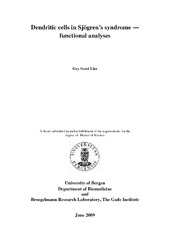Dendritic cells in Sjögren's syndrome-functional analyses
Master thesis
Permanent lenke
https://hdl.handle.net/1956/3420Utgivelsesdato
2009-06-02Metadata
Vis full innførselSamlinger
Sammendrag
Sjögren's syndrome (SS) is an autoimmune disease of unknown etiology. It is characterized by chronic inflammation of the exocrine glands which leads to dryness of the mouth and eyes. Dendritic cells (DC) are the most potent antigen presenting cells of the immune system. They take up antigens in the periphery and migrate to secondary lymphoid tissues where specific T lymphocytes recognize the presented antigen and mount an immune response. So far not much work has been done to examine the possible role of DC in SS. Aim of this study was to functionally analyze monocyte-derived DC (moDC) from patients diagnosed with primary SS compared to healthy controls. Peripheral blood mononuclear cells were isolated from freshly heparinized blood samples from pSS patients fulfilling the American European Consesus group criteria (AECC) and gender- and age-matched healthy controls. Monocytes were isolated by plastic adherence, and immature DC were generated by culturing the monocytes with IL-4 and GM-CSF. A fraction of the cells was stimulated with the TLR7/8 ligand CL097 for 48 hours. In order to investigate functional aspects of moDC, a FITC-dextran assay to explore the endocytic capacity of DC, and a chemotaxis assay to examine migratory capacity of the cells towards CCL19 were performed. Moreover an IL-12p70 ELISA on cell culture supernatants was performed as IL-12 is an inflammatory cytokine which is produced and secreted by mature DC. Finally protein expression of Ro52 and IRF-8 was analyzed on whole cell lysates from moDC by Western blot. Ro52 is a commonly detected autoantigen in patients with SS and IRF-8 is a transcription-factor involved in DC function and differentiation. The results from the endocytosis assay revealed that immature DC from SS patients have a higher endocytic capacity than the cells from healthy controls. The chemotaxis assay showed that mature moDC from patients have higher migratory capacity than the mature moDC from controls. Furthermore the Western blot analysis indicated that Ro52 expression is significantly lower in mature moDC from patients compared to controls. IRF-8 expression was significantly lower in immature DC from SS patients compared to the control group. The ELISA result proposed a slightly higher production of IL-12p70 in mature moDC from patients than from mature moDC from healthy controls. From the experiments which have been performed in this study we conclude that there indeed is a functional difference between the moDC from SS patient and controls. This difference might possibly be caused by an inappropriate stimulus of the immature moDC in SS patients leading to dysfunctional DC. This study also emphasizes the need to continue examining the possible role of DC in SS.
Utgiver
The University of BergenOpphavsrett
Copyright the author. All rights reservedThe author
